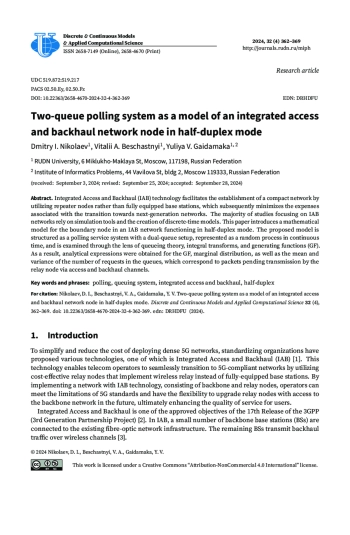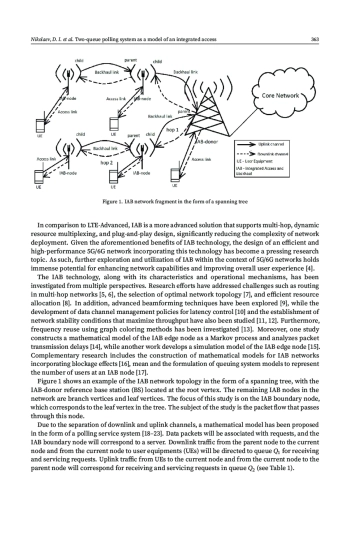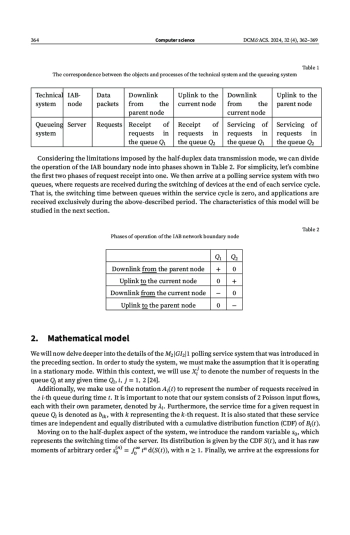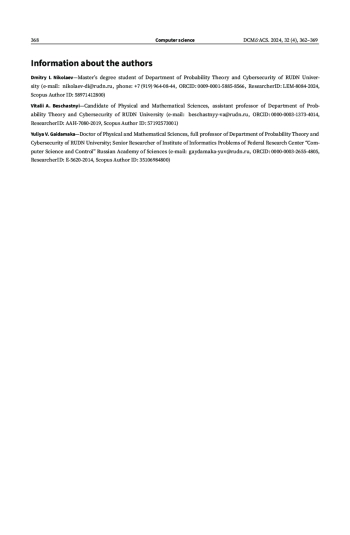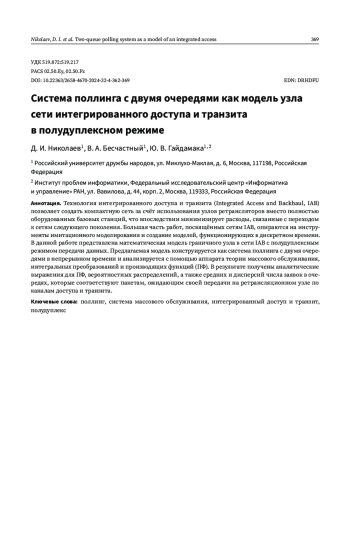Integrated Access and Backhaul (IAB) technology facilitates the establishment of a compact network by utilizing repeater nodes rather than fully equipped base stations, which subsequently minimizes the expenses associated with the transition towards next-generation networks. The majority of studies focusing on IAB networks rely on simulation tools and the creation of discrete-time models. This paper introduces a mathematical model for the boundary node in an IAB network functioning in half-duplex mode. The proposed model is structured as a polling service system with a dual-queue setup, represented as a random process in continuous time, and is examined through the lens of queueing theory, integral transforms, and generating functions (GF). As a result, analytical expressions were obtained for the GF, marginal distribution, as well as the mean and variance of the number of requests in the queues, which correspond to packets pending transmission by the relay node via access and backhaul channels.
Идентификаторы и классификаторы
To simplify and reduce the cost of deploying dense 5G networks, standardizing organizations have proposed various technologies, one of which is Integrated Access and Backhaul (IAB) [1]. This technology enables telecom operators to seamlessly transition to 5G-compliant networks by utilizing cost-effective relay nodes that implement wireless relay instead of fully-equipped base stations. By implementing a network with IAB technology, consisting of backbone and relay nodes, operators can meet the limitations of 5G standards and have the flexibility to upgrade relay nodes with access to the backbone network in the future, ultimately enhancing the quality of service for users.
Список литературы
1. 3GPP: Study on Integrated Access and Backhaul. Technical report (TR) 38.874 v16.0.0 (2018)
2. 3GPP: Integrated Access and Backhaul (IAB) radio transmission and reception. Technical Specification (TS) 38.174 v17.2.0 (2022)
3. Polese, M., Giordani, M., Zugno, T., Roy, A., Goyal, S., Castor, D. & Zorzi, M. Integrated Access and Backhaul in 5G mmWave Networks: Potential and Challenges. IEEE Communications Magazine 58, 62–68. doi:10.1109/MCOM.001.1900346 (Mar. 2020).
4. Sadovaya, Y., Molchanov, D., Mao, W., Orhan, O., Yeh, S.-p., Nikopour, H., Talwur, S. & Andreev, S. Integrated access and backhaul in millimeter-wave cellular: Benefits and challenges. IEEE
Communications Magazine 60, 81–86 (2022).
5. Gomez-Cuba, F. & Zorzi, M. Optimal link scheduling in millimeter wave multi-hop networks with MU-MIMO radios. IEEE Transactions on Wireless Communications 19, 1839–1854 (2020).
6. Alghafari, H. & Sayad Haghighi, M. Decentralized Joint Resource Allocation and Path Selection in Multi-hop Integrated Access Backhaul 5G Networks. Computer Networks, 108837. doi:10.1016/ j.comnet.2022.108837 (Feb. 2022).
7. Madapatha, C. et al. On topology optimization and routing in integrated access and backhaul networks: A genetic algorithm based approach. IEEE Open Journal of the Communications Society 2, 2273–2291 (2021).
8. Tafintsev, N., Moltchanov, D., Yeh, S.-p., Nikopour, H., Mao, W., Orhan, O., Talwar, S., Valkama, M. & Andreev, S. Joint Path Selection and Resource Allocation in Multi-Hop mmWave-based IAB Systems in ICC 2023 - IEEE International Conference on Communications (2023), 4194–4199. doi:10.1109/ ICC45041.2023.10279180.
9. Jayasinghe, P., Tölli, A., Kaleva, J. & Latva-Aho, M. Traffic Aware Beamformer Design for Flexible TDD-Based Integrated Access and Backhaul. IEEE Access 8, 205534–205549. doi:10.1109/ACCESS. 2020.3037814 (2020).
10. Yarkina, N., Moltchanov, D. & Koucheryavy, Y. Counter Waves Link Activation Policy for Latency Control in In-Band IAB Systems. IEEE Communications Letters 27, 3108–3112. doi:10 . 1109 / LCOMM.2023.3313233 (2023).
11. Neely, M. Stochastic Network Optimization with Application to Communication and Queueing Systems doi:10.2200/S00271ED1V01Y201006CNT007 (2010).
12. Tassiulas, L. & Ephremides, A. Stability properties of constrained queueing systems and scheduling policies for maximum throughput in multihop radio networks. IEEE Transactions on Automatic Control 37, 1936–1948. doi:10.1109/9.182479 (1992).
13. Silard, M., Fabian, P., Papadopoulos, G. Z. & Savelli, P. Frequency Reuse in IAB-based 5G Networks using Graph Coloring Methods in 2022 Global Information Infrastructure and Networking Symposium (GIIS) (Argostoli, Greece, 2022), 104–110. doi:10.1109/GIIS56506.2022.9937005.
14. Nikolaev, D. & Gaidamaka, Y. Leaf Node Polling Model Analysis in an Integrated Access and Backhaul Network in Information Technologies and Mathematical Modelling. Queueing Theory and Applications (eds Dudin, A., Nazarov, A. & Moiseev, A.) (Springer Nature Switzerland, Cham, 2024), 106–117. doi:10.1007/978-3-031-65385-8_8.
15. Feoktistov, V., Nikolaev, D., Gaidamaka, Y. & Samouylov, K. Analysis of Probabilistic Characteristics in the Integrated Access and Backhaul System in Distributed Computer and Communication Networks: Control, Computation, Communications (eds Vishnevskiy, V. M., Samouylov, K. E. & Kozyrev, D. V.) (Springer Nature Switzerland, Cham, 2024), 277–290. doi:10.1007/978-3-031-50482-2_22.
16. Khayrov, E. & Koucheryavy, Y. Packet Level Performance of 5G NR System Under Blockage and Micromobility Impairments. IEEE Access 11, 90383–90395. doi:10.1109/ACCESS.2023.3307021 (2023).
17. Salimzyanov, R. & Moiseev, A. Local balance equation for the probability distribution of the number of customers in the IAB network in SUITMM, Omsk (2023), 284–289.
18. Rykov, V. On analysis of periodic polling systems. Autom. Remote Control 70, 997–1018. doi:10. 1134/S0005117909060071 (2009).
19. Takagi, H. Analysis of polling systems p. 175. 175 pp. (MIT Press, 1986).
20. Takagi, H. & Kleinrock, L. A tutorial on the analysis of polling systems p. 172. 172 pp. (UCLA Computer Science Department, 1985).
21. Takagi, H. Mean message waiting times in symmetric multiqueue systems with cyclic service. Performance Evaluation 5, 271–277 (1985).
22. Zaripova, E. Metody analiza pokazateley effektivnosti telekommunikatsionnoy seti serverov protokola ustanovleniya sessiy [Methods of analyzing the efficiency indicators of the telecommunication network of session establishment protocol servers] p. 18. PhD thesis (RUDN, Moscow, 2015), 18.
23. Ge, J., Bao, L., Ding, H. & Ding, X. Performance Analysis of the First-order Characteristics of Two-level Priority Polling System Based on Parallel Gated and Exhaustive Services Mode in 2021 IEEE 4th International Conference on Electronic Information and Communication Technology (ICEICT) (2021), 10–13. doi:10.1109/ICEICT53123.2021.9531122.
24. Vishnevsky, V. & Semenova, O. Sistemy pollinga: Teoriya i primenenie v shirokopolosnykh besprovodnykh setyakh [Polling systems. Theory and applications for broadband wireless networks] p. 312. 312 pp. (Tekhnosfera, Moscow, 2012).
Выпуск
Другие статьи выпуска
Superconducting properties of twisted tri-layer graphene (TTG) are studied within the scope of the chiral model based on using the unitary matrix
In this article, we propose fourth- and fifth-order two-step iterative methods for solving the systems of nonlinear equations in
Earlier we developed a stable fast numerical algorithm for solving ordinary differential equations of the first order. The method based on the Chebyshev collocation allows solving both initial value problems and problems with a fixed condition at an arbitrary point of the interval with equal success. The algorithm for solving the boundary value problem practically implements a single-pass analogue of the shooting method traditionally used in such cases. In this paper, we extend the developed algorithm to the class of linear ODEs of the second order. Active use of the method of integrating factors and the d’Alembert method allows us to reduce the method for solving second-order equations to a sequence of solutions of a pair of first-order equations. The general solution of the initial or boundary value problem for an inhomogeneous equation of the second order is represented as a sum of basic solutions with unknown constant coefficients. This approach ensures numerical stability, clarity, and simplicity of the algorithm.
The problem of summation of Fourier series in finite form is formulated in the weak sense, which allows one to consider this problem uniformly both for classically convergent and for divergent series. For series with polynomial Fourier coefficients
Various approaches to calculating normal modes of a closed waveguide are considered. A review of the literature was given, a comparison of the two formulations of this problem was made. It is shown that using a self-adjoint formulation of the problem of normal waveguide modes eliminates the occurrence of artifacts associated with the appearance of a small imaginary additive to the eigenvalues. The implementation of this approach for a rectangular waveguide with rectangular inserts in the Sage computer algebra system is presented and tested on hybrid modes of layered waveguides. The tests showed that our program copes well with calculating the points of the dispersion curve corresponding to the hybrid modes of the waveguide.
The paper considers a single-line retrial queueing system with an unreliable server. Queuing systems are called unreliable if their servers may fail from time to time and require restoration (repair), only after which they can resume servicing customers. The input of the system is a simple Poisson flow of customers. The service time and uptime of the server are distributed exponentially. An incoming customer try to get service. The server can be free, busy or under repair. The customer is serviced immediately if the server is free. If it is busy or under repair, the customer goes into orbit. And after a random time it tries to get service again. The study is carried out by the method of asymptotically diffusion analysis under the condition of a large delay of requests in orbit. In this work, the transfer coefficient and diffusion coefficient were found and a diffusion approximation was constructed.
The paper presents a new multimodal approach to analyzing the psycho-emotional state of a person using nonlinear classifiers. The main modalities are the subject’s speech data and video data of facial expressions. Speech is digitized and transcribed using the Scribe library, and then mood cues are extracted using the Titanis sentiment analyzer from the FRC CSC RAS. For visual analysis, two different approaches were implemented: a pre-trained ResNet model for direct sentiment classification from facial expressions, and a deep learning model that integrates ResNet with a graph-based deep neural network for facial recognition. Both approaches have faced challenges related to environmental factors affecting the stability of results. The second approach demonstrated greater flexibility with adjustable classification vocabularies, which facilitated post-deployment calibration. Integration of text and visual data has significantly improved the accuracy and reliability of the analysis of a person’s psycho-emotional state
We describe introduced in the journal the rubric system. We describe the general structure of an IMRAD research publication. The IMRAD structure for a research article is described in detail.
Статистика статьи
Статистика просмотров за 2025 год.
Издательство
- Издательство
- РУДН
- Регион
- Россия, Москва
- Почтовый адрес
- 117198, г. Москва, ул. Миклухо-Маклая, д. 6
- Юр. адрес
- 117198, г Москва, Обручевский р-н, ул Миклухо-Маклая, д 6
- ФИО
- Ястребов Олег Александрович (РЕКТОР)
- E-mail адрес
- rector@rudn.ru
- Контактный телефон
- +7 (495) 4347027
- Сайт
- https://www.rudn.ru/

